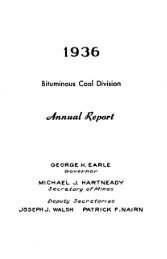Reports of the Inspectors of Mines of the anthracite coal regions of ...
Reports of the Inspectors of Mines of the anthracite coal regions of ...
Reports of the Inspectors of Mines of the anthracite coal regions of ...
You also want an ePaper? Increase the reach of your titles
YUMPU automatically turns print PDFs into web optimized ePapers that Google loves.
Ex. Doc] <strong>Reports</strong> <strong>of</strong> <strong>the</strong> <strong>Inspectors</strong> op <strong>Mines</strong>. 205<br />
Explanations.<br />
* Marked thus is <strong>the</strong> pressure as indicated by <strong>the</strong> gauge on <strong>the</strong> water<br />
cylinder while <strong>the</strong> pump was running. The o<strong>the</strong>r pressure in <strong>the</strong> same<br />
column is <strong>the</strong> hydrostatic pressure. The pumping capacity to <strong>the</strong> surface<br />
previous to putting in pumps, Nos. 1, 2, and 3, was 1,119 gallons per min-<br />
ute. Since <strong>the</strong> caving in <strong>of</strong> <strong>the</strong> adjoining colliery it has increased to 2,206<br />
gallons per minute, exclusive <strong>of</strong> <strong>the</strong> pumps that were in, or about double.<br />
The increased quantity <strong>of</strong> water issuing through <strong>the</strong> barrier pillar is found<br />
to be about 1,846.8 gallons per minute, or about *715 gallons per minute<br />
more than <strong>the</strong> capacity <strong>of</strong> <strong>the</strong> old pumps that were in slope Nos. 1 and 2.<br />
Length <strong>of</strong> slope. No. 1, to first lift, 333 feet ; to second lift, 679 feet ; to<br />
third lift, 820 feet. Length <strong>of</strong> slope. No. 2, to second lift, 679 feet; to<br />
third lift, 853^ feet. Distance from bottom <strong>of</strong> slope to Clark pump, 50<br />
feet. Distance from No. 1 boilers to mouth <strong>of</strong> slope, 75 feet. Distance<br />
from No. 2 boilers to mouth <strong>of</strong> slope, 75 feet. Distance from Allison<br />
pump to Salkeld's, 50 feet. Diameter <strong>of</strong> steam pipe is 6" for a distance<br />
<strong>of</strong> 450 feet fi'om <strong>the</strong> boilers, and 5" for 150 feet; <strong>the</strong> remaining distance<br />
<strong>of</strong> 295 feet is 4" diameter to <strong>the</strong> pumps. Pumps Nos. 6 and 7 ai'e only<br />
used in case <strong>of</strong> heavy water. At <strong>the</strong> bottom <strong>of</strong> slope No. 2, a 2^" steam<br />
pipe connects with a 4", to convey steam to <strong>the</strong> Cameron's, a lift <strong>of</strong> 74<br />
feet below <strong>the</strong> duplex pump. Pump Nos. 1 and 2 pumps <strong>the</strong> water up to<br />
pump No. 3, (208 feet, vertical,) indicate an excess capacity <strong>of</strong> 55 per<br />
cent., and pump No. 3 shows a surplus capacity <strong>of</strong> 33 per cent., independent<br />
<strong>of</strong> <strong>the</strong> old pumps, and pumps to <strong>the</strong> surface. Pump No. 5 pumps<br />
from third lift, in slope No. 2, to pump No. 4, and pump No. 4 pumps to<br />
<strong>the</strong> surface, 350 feet vertical. Pump No. 6 is located between pump Nos.<br />
1 and 2, and is only used in case <strong>of</strong> necessity. Pump No. 7 assists pump<br />
No. 3 when needed. The steam pipes are covered by placing laths on <strong>the</strong><br />
pipes, I <strong>of</strong> an inch square and 3" apart, full length <strong>of</strong> <strong>the</strong> pipe, and are<br />
<strong>the</strong>n tied on with wire wound around <strong>the</strong> laths and pipe, after which a<br />
straw rope, 1^'' diameter, is wound around <strong>the</strong> laths, leaving an air space<br />
<strong>of</strong> f" between <strong>the</strong> pipe and <strong>the</strong> covering; <strong>the</strong>n a mixture <strong>of</strong> coarse sand,<br />
some lime, and cut straw is pttt on, for a coating, making a covering <strong>of</strong> 3-§-<br />
inches, exclusive <strong>of</strong> <strong>the</strong> laths. This is considered by many <strong>of</strong> <strong>the</strong> superintendents<br />
here to be nearly equal to <strong>the</strong> material put on by <strong>the</strong> patentees, and<br />
costing a great deal less. 1 am unable to give <strong>the</strong> proportion <strong>of</strong> <strong>the</strong> ad-<br />
mixture, as <strong>the</strong>y did not keep an account <strong>of</strong> <strong>the</strong> amount <strong>of</strong> <strong>the</strong> ingredients<br />
composing <strong>the</strong> coating or covering. The percentage <strong>of</strong> useful effect, as is<br />
given in this table, is, indeed, very high, as <strong>the</strong> work done b}' <strong>the</strong> power<br />
spent seldom exceeds 50 per cent. The pumps all exhaust into <strong>the</strong> suc-<br />
tion, or tail pipe, and operate very satisfactorily. The intention <strong>of</strong> tliis<br />
table, in <strong>the</strong> first place, was to show <strong>the</strong> increase quantity'<strong>of</strong> water caused<br />
by <strong>the</strong> caving in <strong>of</strong> <strong>the</strong> adjoining colliery, or in not reserving sufficient<br />
barrier pillar to resist 320 feet head <strong>of</strong> water; and, as <strong>the</strong> raining law does<br />
not specify how near <strong>the</strong> different parties can work to <strong>the</strong> same, I did not




![1945 Anthracite Annual Report Districts 19 - 25 [Adobe pdf - 9148Kb]](https://img.yumpu.com/50308099/1/190x119/1945-anthracite-annual-report-districts-19-25-adobe-pdf-9148kb.jpg?quality=85)


![1937 Anthracite Annual Report Districts 1 - 11 [Adobe pdf - 9394Kb]](https://img.yumpu.com/43539962/1/190x119/1937-anthracite-annual-report-districts-1-11-adobe-pdf-9394kb.jpg?quality=85)







![1931 Anthracite Annual Report Districts 1 - 11 [Adobe pdf - 8007Kb]](https://img.yumpu.com/39427789/1/190x119/1931-anthracite-annual-report-districts-1-11-adobe-pdf-8007kb.jpg?quality=85)

